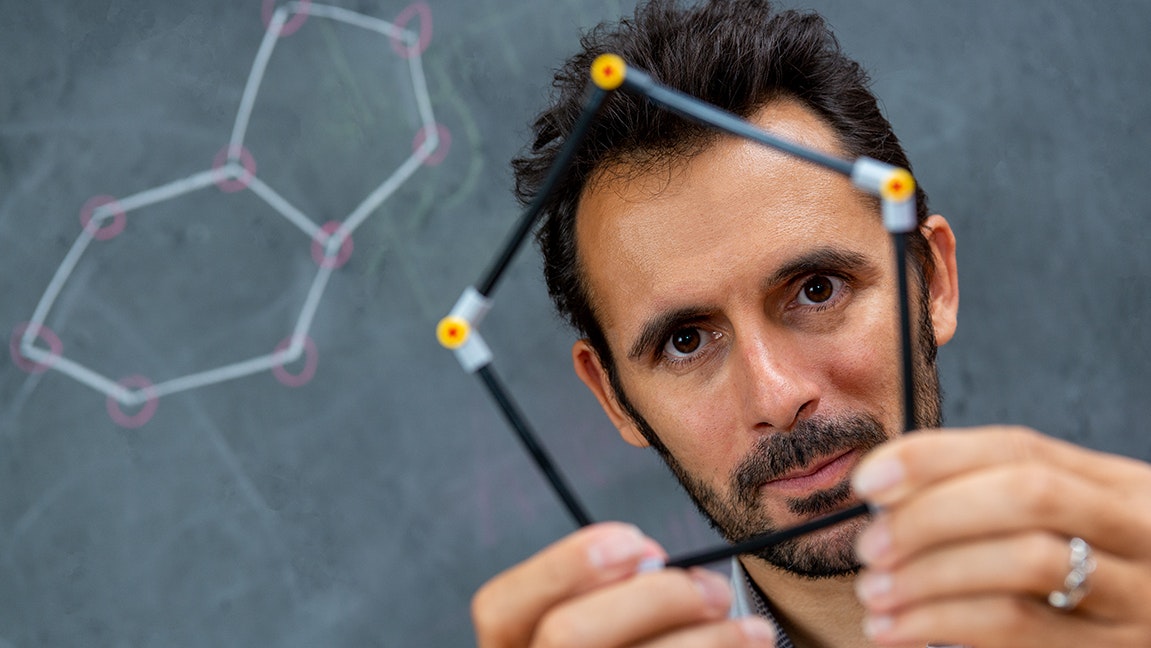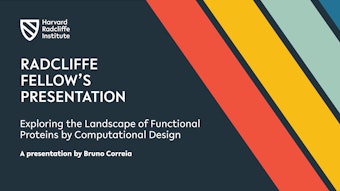Powered by Proteins

The bioengineer Bruno Correia’s ongoing fascination with the “workhorses of life.”
Bruno Correia had his aha moment at 21. He was three unhappy years into a chemistry degree in Portugal and thinking about abandoning the field when his professor flashed a picture of a protein structure up on a computer screen.
The young student was dumbstruck.
“I couldn’t fully comprehend what was going on,” recalls Correia, a bioengineer and the 2022–2023 Grass Fellow at Harvard Radcliffe Institute. “But just the sheer beauty of the object itself is something I could not let go.”
He’s held fast to that seminal moment ever since, finishing his bachelor’s degree, earning his PhD in computational biology, and devoting much of his career to proteins—or, as he likes to call them, “the workhorses of life.” Today, as an associate professor at the École Polytechnique Fédérale de Lausanne, Correia’s protein work takes after a quote from one of his science idols, the molecular biologist Francis Crick, famous for helping develop the three-dimensional model of the DNA double helix: “If you want to understand function,” said Crick, “study structure.”
Developing new ways to study protein structure is at the heart of much of Correia’s current research, work that has the potential to unlock new immunotherapy treatments for cancer, addiction, and a host of other conditions. But it’s not for the impatient or the numerically challenged.
One main hurdle with protein engineering is the sheer scope of the job. Proteins are made of chains of 20 amino acids that can link together with other chains, with each chain able to arrange its amino acids in more than a million unique combinations. When trying to study combinations in a set of multiple chains, “very quickly you get to a number that is larger than the number of atoms in the universe,” says Correia. But he and his lab have come up with an ingenious solution.
“We use structural representations to help us navigate through this space.”
That work involves MaSIF (molecular surface interaction fingerprinting), an algorithm Correia and his collaborators designed in their Swiss lab that enables them to map out the surface of proteins. Unlike other computer programs that break down the large complex molecules into three-dimensional representations of their atomic parts, Correia and his colleagues pull back the lens. Similar to how images from the Mars rovers help scientists analyze the canyons and volcanoes on the red planet’s surface, the team’s simulated surface models allow researchers to study a protein’s chemical and geometric traits or fingerprints.
“We theorize that proteins taking part in similar interactions share these common fingerprints,” says Correia. “And with the help of MaSIF we can analyze those fingerprints much more quickly using large-scale datasets.”
The information they obtain is helping them understand how proteins function, how to alter proteins to make them act in a certain way, and even how to create new proteins from scratch in the lab.
“In general, biologists and chemists try to understand how these proteins work, how they carry out their biological functions,” says Correia. “As protein engineers, we try to understand how we can change proteins, so that we get them to do what we want them to.
“And it’s all about the surface because physical interactions mostly occur through the surface of protein molecules—they don’t occur through the parts that are not exposed.”

At Radcliffe, Correia is studying the surfaces of protein molecules in hopes of predicting how and if the immune system will react to them. Photo by Lou Jones
In a fitting Harvard twist, the work has come full circle. Correia developed his initial vision for MaSIF with the 2017–2018 Radcliffe fellow and computer scientist Michael Bronstein, who invited him to visit the Cambridge campus for a week in 2018. Together, they sketched out their idea. Soon, they had a concrete algorithm ready to try.
“I felt like it was an incredible place to be, just to have some thoughts that were outside of the box,” he says. “And now I am back for a second round.”
Correia believes the work could have wide-reaching implications, noting that the COVID vaccine that has helped save countless lives is powered by a protein. “The mRNA that’s delivered into cells makes a protein for you,” says Correia. “And that's what your immune system recognizes, and sees, and starts making antibodies against. And suddenly you're protected against the virus.”
At Radcliffe, Correia is delving deeper into understanding how the immune system works. He and colleagues from around the globe are trying to develop a new framework for studying surfaces of protein molecules using MaSIF in order to predict how and if the immune system will react to them.
“Oftentimes, the reason vaccines don’t work is because the immune system is paying attention to the wrong parts of the molecule. It gets very distracted with parts of the molecule that aren’t important,” says Correia. “If we can study the surface features that we want the immune system to ignore, we can then actually engineer the molecule so that we can modulate that reaction.”
When he’s not busy Zooming with his collaborators, discussing a tweak to his algorithm, or tracking the progress of protein molecules being synthesized in the lab, Correia enjoys spending time with his wife and two young children in Cambridge. They are embracing the faster pace of life in Harvard Square, a bustling hub compared to their home in a bucolic village outside of Lausanne, where his nearest neighbors are a handful of cows.
He’s also taking regular breaks from his sophisticated software to engage with his Radcliffe cohort. “There are so many dimensions to the world which I am not used to thinking about in my scientific bubble,” says Correia, who just finished a book by Marilyn Beaudry-Corbett Schlesinger Fellow Jennifer Finney Boylan and is currently reading one by Lillian Gollay Knafel Fellow Dima Alzayat. “Connecting with my colleagues here is changing the way I look at the world,” says Correia. “And the way you look at the world influences everything you do.”
Colleen Walsh is a freelance writer.








